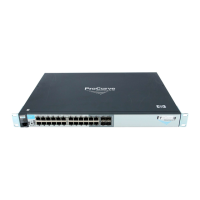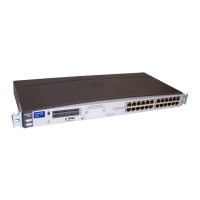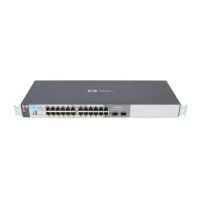Port Trunking
Trunk Group Operation Using LACP
Static LACP Provides a manually configured, static LACP trunk to accommodate these conditions:
LACP Port Trunk
Configuration
Operation
• The port on the other end of the trunk link is configured for a static LACP trunk.
• You want to configure non-default spanning tree or IGMP parameters on an LACP trunk group.
• You want an LACP trunk group to operate in a VLAN other than the default VLAN and GVRP is
disabled. (Refer to “VLANs and Dynamic LACP” on page 12-23.)
• You want to use a monitor port on the switch to monitor an LACP trunk.
The trunk operates if the trunk group on the opposite device is running one of the following trunking
protocols:
• Active LACP
• Passive LACP
• Trunk
This option uses LACP for the port Type parameter and TrkX for the port Group parameter, where X is
an automatically assigned value in a range corresponding to the maximum number of trunks the switch
allows. (The table on page 12-5 lists the maximum number of trunk groups allowed on the switches
covered in this guide.)
Displaying Static LACP Trunk Data: To list the configuration and status for a static LACP trunk, use the
CLI
show lacp command. To list a static LACP trunk with its assigned ports, use the CLI show trunk
command or display the menu interface Port/Trunk Settings screen.
Static LACP does not allow standby ports.
Default Port Operation
In the default configuration, LACP is disabled for all ports. If LACP is not
configured as Active on at least one end of a link, then the port does not try
to detect a trunk configuration and operates as a standard, untrunked port.
Table 12-5 lists the elements of per-port LACP operation. To display this data
for a switch, execute the following command in the CLI:
ProCurve> show lacp
Table 12-5. LACP Port Status Data
Status Name Meaning
Port Numb Shows the physical port number for each port configured for LACP operation (C1, C2, C3 …). Unlisted port
numbers indicate that the missing ports are assigned to a static Trunk group are not configured for any
trunking.
LACP Enabled Active: The port automatically sends LACP protocol packets.
Passive: The port does not automatically send LACP protocol packets, and responds only if it receives
LACP protocol packets from the opposite device.
A link having either two active LACP ports or one active port and one passive port can perform dynamic
LACP trunking. A link having two passive LACP ports will not perform LACP trunking because both ports
are waiting for an LACP protocol packet from the opposite device.
Note: In the default switch configuration, LACP is disabled for all ports.
12-20
